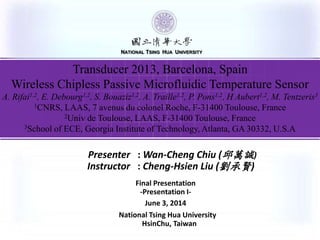102035504ÇñÈfÕ\ final presentation
- 1. °´Ò»ÏÂÒÔ¾ŽÝ‹Ä¸Æ¬˜Ëî}˜Óʽ NATIONAL TSING HUA UNIVERSITY National Tsing Hua University HsinChu, Taiwan Presenter : Wan-Cheng Chiu (ÇñÈfÕ\) Instructor : Cheng-Hsien Liu („¢³ÐÙt) Final Presentation -Presentation I- June 3, 2014 NATIONAL TSING HUA UNIVERSITY Transducer 2013, Barcelona, Spain Wireless Chipless Passive Microfluidic Temperature Sensor A. Rifai1,2, E. Debourg1,2, S. Bouaziz1,2, A. Traille1,2, P. Pons1,2, H Aubert1,2, M. Tentzeris3 1CNRS, LAAS, 7 avenus du colonel Roche, F-31400 Toulouse, France 2Univ de Toulouse, LAAS, F-31400 Toulouse, France 3School of ECE, Georgia Institute of Technology, Atlanta, GA 30332, U.S.A
- 2. NATIONAL TSING HUA UNIVERSITY National Tsing Hua University 2 ? Introduction ? Principle ? Concept ? Fabrication ? Characterization ? Conclusion Outline
- 3. NATIONAL TSING HUA UNIVERSITY National Tsing Hua University 3 ? Introduction ? Principle ? Concept ? Fabrication ? Characterization ? Conclusion Outline
- 4. NATIONAL TSING HUA UNIVERSITY National Tsing Hua University Introduction Active Sensor Passive Sensor Transmit Receive Transmit Receive
- 5. NATIONAL TSING HUA UNIVERSITY National Tsing Hua University Introduction Bimorph Cantilever Variation of Dielectric Constant Transmit Receive Transmit Receive Temperature Sensor: Temp. Beams bent down Frequency Temp. Dielectric constant changes Frequency 20 ¡æ to 300 ¡æ 19.45 to 19.30 GHz 50 ¡æ to 1000 ¡æ 5.12 to 4.74 GHz
- 6. NATIONAL TSING HUA UNIVERSITY National Tsing Hua University 6 ? Introduction ? Principle ? Concept ? Fabrication ? Characterization ? Conclusion Outline
- 7. NATIONAL TSING HUA UNIVERSITY National Tsing Hua University 7 Principle ?For two parallel plate: + V - g Capacitance = ¦ÅA/g ¦Å, permittivity changes for different medium between the two plates. Material Permittivity Vacuum 1 Air ~1 Water ~80 SiO2 3.9
- 8. NATIONAL TSING HUA UNIVERSITY National Tsing Hua University 8 ? Introduction ? Principle ? Concept ? Fabrication ? Characterization ? Conclusion Outline
- 9. NATIONAL TSING HUA UNIVERSITY National Tsing Hua University 9 Concept As temperature rises liquid dilates Plate capacitors both 100nm thick ?Device Mechanism: As the temperature rises, the dilated liquid will change the permittivity between capacitors thus causing a capacitance change. Glass substrate to reduce loss Operating frequency fixed at 29.75GHz to match their radar.
- 10. NATIONAL TSING HUA UNIVERSITY National Tsing Hua University 10 Concept Materials Permittivity Air ~1 Water ~80 As temperature increases and water fills up the channel, the reflection coefficient decreases. ~The simulation proves this method can work.~ Reflection Coefficient versus Frequency 12.5% 25% 37.5% 50% 62.5% 75% 87.5%
- 11. NATIONAL TSING HUA UNIVERSITY National Tsing Hua University 11 Concept The geometry of the capacitor was tuned to allow a S11 full scale of 9dB between full and empty channel. 400 ¦Ìm 400 ¦Ìm
- 12. NATIONAL TSING HUA UNIVERSITY National Tsing Hua University Concept Without Water With Water Capacitor Surface Capacitor Surface Vertical Axis Vertical Axis Electric field without water is stronger and 100¦Ìm thick water is enough to confine the electromagnetic field
- 13. NATIONAL TSING HUA UNIVERSITY National Tsing Hua University 13 ? Introduction ? Principle ? Concept ? Fabrication ? Characterization ? Conclusion Outline
- 14. NATIONAL TSING HUA UNIVERSITY National Tsing Hua University 14 Fabrication Glass substrate Glass substrate Glass substrate 1. 2. Metalized with Ti/Cu, then patterned 3. 3050-SU8 spun on, then patterned Glass substrate 4. Lamination of 3050-SU8
- 15. NATIONAL TSING HUA UNIVERSITY National Tsing Hua University 15 ? Introduction ? Principle ? Concept ? Fabrication ? Characterization ? Conclusion Outline
- 16. NATIONAL TSING HUA UNIVERSITY National Tsing Hua University Characterization Temperature range of 9¡æ(24 ¡æ ~33 ¡æ) from beginning to end of capacitor electrode. ~43¦Ìm/¡æ
- 17. NATIONAL TSING HUA UNIVERSITY National Tsing Hua University 17 Characterization ?S11~8dB for a full scale range This corresponds to a capacitance shift between 20fF and 140fF
- 18. NATIONAL TSING HUA UNIVERSITY National Tsing Hua University 18 Characterization Reflection Coefficient for Various Liquid Filling the Channel PG: propylene glycol EG: ethylene glycol S11 full scale variation are too low for pure EG or PG (less than 1dB). A mixture water and PG or EG (50%/50%) shows an increase up to 6dB.
- 19. NATIONAL TSING HUA UNIVERSITY National Tsing Hua University 19 ? Introduction ? Principle ? Concept ? Fabrication ? Characterization ? Conclusion Outline
- 20. NATIONAL TSING HUA UNIVERSITY National Tsing Hua University 20 ? A new concept of passive temperature sensor based on electromagnetic coupling between an RF capacitor and dielectric liquid has been presented. ? This type of temperature sensor obtained a high sensitivity. ? Water has been replaced to avoid evaporation problem. Conclusion
- 21. NATIONAL TSING HUA UNIVERSITY National Tsing Hua University 21 ~Thanks for your attention~





















